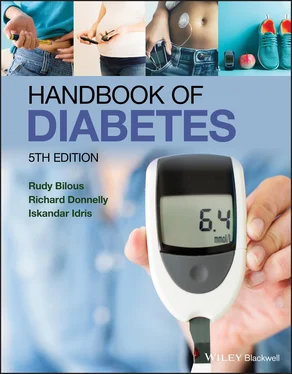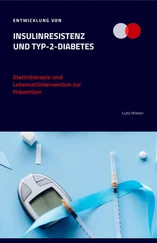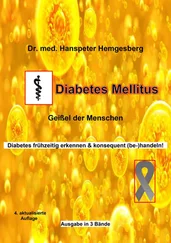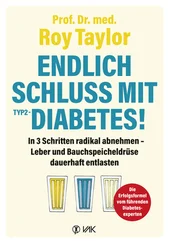Data from Padaiga et al. Diabetic Med 1999; 16: 1–8.
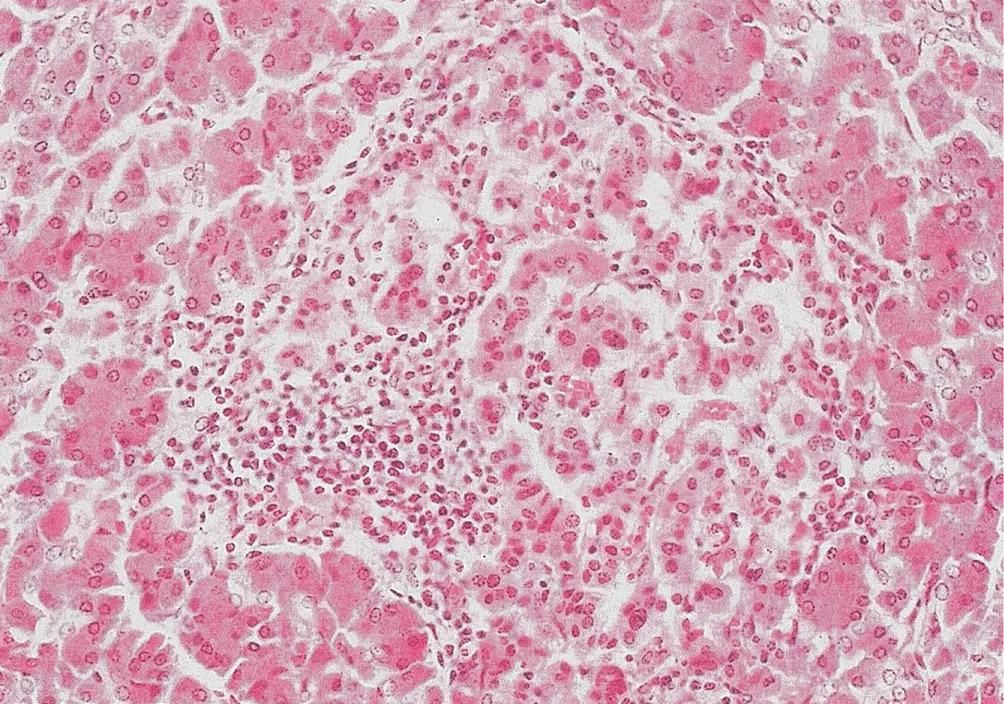
Figure 6.4 Insulitis. There is a chronic inflammatory cell infiltrate centred on this islet. Haematoxylin–eosin stain, original magnification ×300.
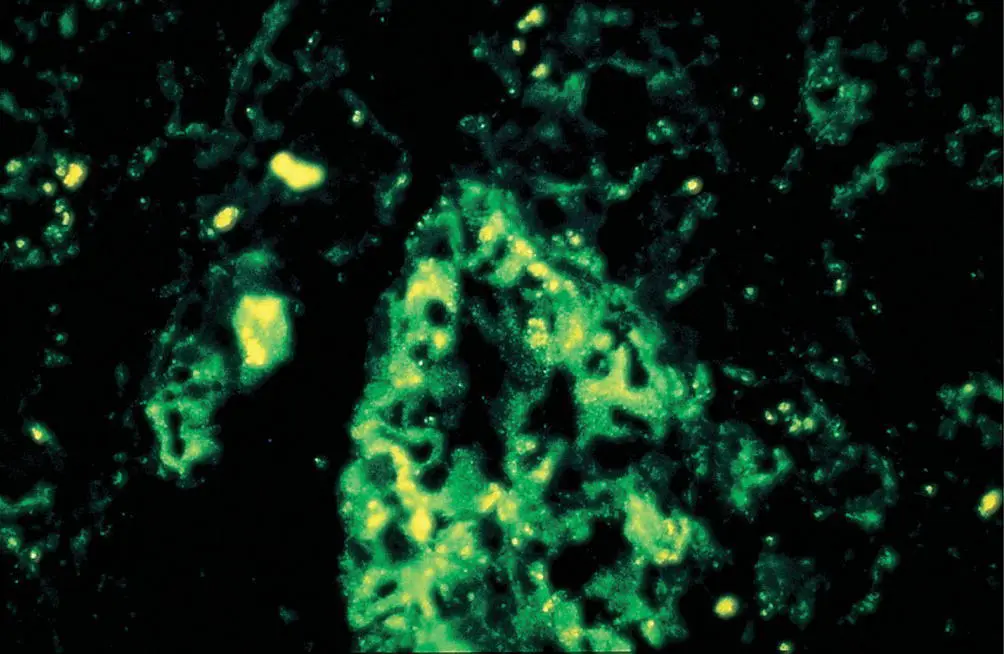
Figure 6.5 ICA demonstrated by indirect immunofluorescence in a frozen section of human pancreas.
The detection of ICAs and GAD antibodies in older persons with type 2 diabetes in Finland and the UKPDS, who were shown subsequently to be more likely to require insulin therapy, has led to the concept of latent autoimmune diabetes of adults (LADA). Although GAD positivity had a specificity of 94.6% for early insulin use in the UKPDS, its sensitivity was only 37.9%. Moreover, the positive predictive value for GAD‐positive antibodies was only 50.8% (i.e. only half of those positive went on to need insulin). Nonetheless, it is now accepted that LADA represents a distinct entity on the spectrum of autoimmune diabetes. It is now thought that LADA may represent 4–14% of people diagnosed as type 2 diabetes, which would make it more prevalent than childhood type 1 diabetes in Europe, and it is the most common cause of autoimmune diabetes in China. GAD65 autoantibodies are positive in 7–14%, IA–2 and ZnT8 are less common. It shares genetic features of both type 1 and 2 diabetes but is phenotypically closer to type 2. However, LADA is characterised by a lower age of onset, lower BMI, greater need for insulin within 6 months of diagnosis, and a tendency for worse glycaemic control. Thyroid peroxidase antibodies were positive in 27% of patients in one Italian study. There may be value in screening people who are thought to have LADA for autoantibodies as early insulin therapy is indicated, although there are no trials of specific therapeutic strategies to guide treatment.
The autoimmune basis for type 1 diabetes is underlined by its association with other diseases such as hypothyroidism, Graves’ disease, pernicious anaemia, coeliac disease and Addison’s disease which are all associated with organ‐specific autoantibodies ( Box 6.1). Up to 30% of people with type 1 diabetes have autoimmune thyroid disease. NICE guidance recommends screening all newly diagnosed children with type 1 diabetes for coeliac disease.
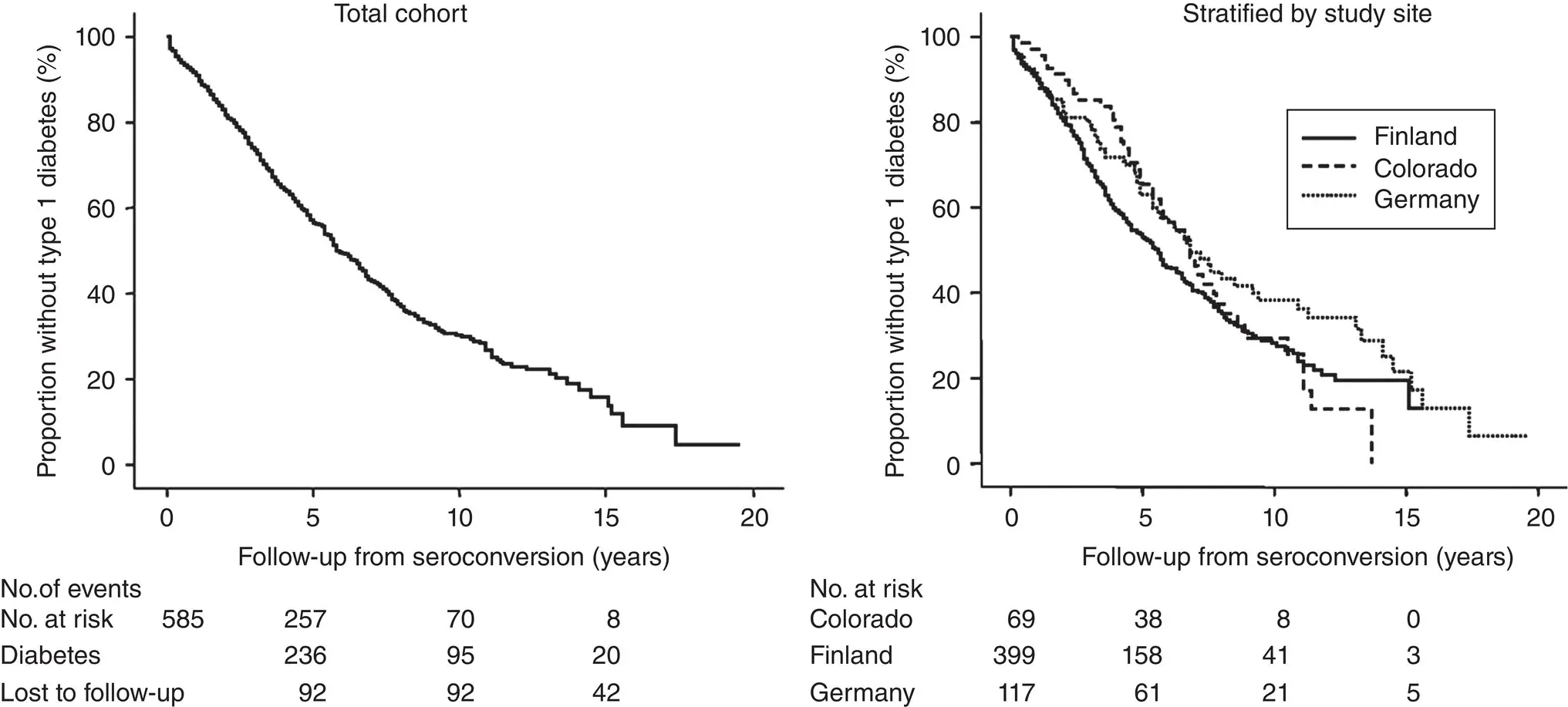
Figure 6.6 Progression to symptomatic Type 1 Diabetes in 585 children with two or more antibodies enrolled into three prospective studies in Finland (DIPP), USA (DAISY) and Germany (BABYDIAB & BABYDIET). Symptomatic diabetes developed in 43.5% at 5 years, 69.7% at 10 years and 84.2% at 15 years follow‐up.
Reproduced from Insel RA et al. Diabetes Care 2015; 38: 1964–74.
Box 6.1Autoimmune disorders associated with type 1 diabetes.
Addison’s disease
Graves’ disease
Hypothyroidism
Hypogonadism
Pernicious anaemia
Vitiligo
Autoimmune polyglandular syndromes, types 1 and 2
Coeliac disease
The mechanisms leading to autoimmunity have not been elucidated, and are almost certainly multiple with different factors operating in different individuals. What is clear is that exposure to environmental factors impacts upon genetically susceptible individuals to trigger an inflammatory response that ultimately leads to β cell loss and symptomatic diabetes.
Genetic susceptibility to type 1 diabetes is most closely associated with HLA genes that lie within the major histocompatibility complex (MHC) region on the short arm of chromosome 6. HLAs are cell surface glycoproteins that show extreme variability through polymorphisms in the genes that code for them. Both high‐ and low‐risk HLA haplotypes have been identified. HLA DR4–DQ8 and DR3–DQ2 confer high risk: the odds ratios for developing type 1 diabetes are 8–11 and 3.6 respectively for each, and 16 for both. 90% of Europid people with type 1 diabetes carry one or the other, and 30% carry both, compared to just 2% in the general population. Siblings sharing the exact DR3–DQ2 and DR4–DQ8 haplotypes with the proband have a >85% risk of developing diabetes before the age of 15 years. HLA DR3 and DR4 susceptibility haplotypes account for around 50% of the heritability of type 1 diabetes. Protective alleles include DQB1*0602, DQA1*0102 and DRB1*1501. DQB1*0602 is present in around 20% of the non‐Hispanic white population but only 2% of people with type 1 diabetes. HLA susceptibility and protective haplotypes differ across ethnic groups. In African–Americans, the DR3 haplotype versions are very similar to those seen in non‐Hispanic white populations, yet are protective, whereas the DR7 haplotype which is protective in non‐Hispanic whites confers susceptibility.
Class II HLAs (HLA–D) play a key role in presenting foreign and self‐antigens to T‐helper lymphocytes and therefore in initiating the autoimmune process. Polymorphisms in the DR and DQ genes will encode for different amino acids in the peptide binding pockets of the HLA molecules. This affects the binding affinity and range of peptides that are presented to T cells, including potential autoantigens derived from the β cell. This is a likely critical step in ‘arming’ T lymphocytes, which initiate the immune attack against the β cells. Class I HLA alleles (A, B and C) also modify risk for type 1 diabetes but much less so than class II and usually in interaction. Class I/peptide antigen complexes play a role in CD8 T cell mediated cytotoxicity.
The current understanding of the events leading to β cell damage is as follows: Insulitis represents activation of CD4 and CD8 lymphocytes, CD 68 macrophages, and CD 20 B cells. CD 4 cell activation is related to HLA Class II protein expression, whilst CD 8 cells are related to HLA Class I; both are involved in initiation of insulitis and β cell loss, whereas CD 20 B cells appear to determine progression, and high or low expression results in fast or slow development of symptomatic type 1 diabetes.
Over 50 other regions of the human genome have been identified as being associated with type 1 diabetes using the candidate gene and genome‐wide scanning (GWAS) approaches, and together these explain around 80% of heritability. Some of the major genetic polymorphisms and their likely role in Type 1 diabetes are shown in Table 6.2. Combination of the HLA susceptibility genes and PTPN22 and UBASH3A polymorphisms improved the predictability of developing type 1 diabetes by age 15 years to 45%, compared to only 3% in children who had the other combined genotypes. Prospective studies have shown that different genetic polymorphisms affect different stages of the disease process; DR3–DQ2 and DR4–DQ8 together with PTPN22 and UBASH3A seem to influence the development of autoantibodies, whereas INS, UBASH3A and IFIH1 impact upon the progression to symptomatic diabetes.
Table 6.2 Main non‐ HLA polymorphisms that have been used in predictive modelling, and their possible role in type 1 diabetes. PTNP22 polymorphisms are shared with other autoimmune diseases such as rheumatoid arthritis and inflammatory bowel disease.
| Genetic polymorphism |
Possible impact |
| Insulin gene (INS) |
Affects amount of insulin mRNA in thymus and influences immune tolerance |
| Protein tyrosine phosphatase non‐receptor type 22 (PTPN22) |
Promotes survival of auroreactive T cells in thymus and functional effects on circulating effector and regulator T cells and B cells |
| Cytotoxic T lymphocyte associated protein (CTLA‐4) |
Negative regulator of cytotoxic T cells Target for Abatacept therapy |
| Interleukin‐2 receptor subunit α (IL2RA) |
Affects sensititvity to IL2 |
| Protein tyrosine phosphatase non‐receptor type 2 (PTPN2) |
β cell apoptosis after interaction with interferon |
| Interferon induced helicase (IFIH1) |
Binds to virus RNA and moderates interferon mediated viral response |
| Basic leucine zipper transcription factor 2 (BACH2) |
Regulates apoptotic pathways in β cells in conjunction with PTNP2 |
| Ubiquitin associated and SH3 domain‐containing protein A (UBASH3A) |
Downregulates Nfκβ signaling pathway in response to T cell stimulation decreasing IL‐2 gene expression |
| erb‐b2 receptor tyrosine kinase 3 (ERBB3) |
Uncertain role in diabetes. Encodes a member of the epidermal growth factor receptor family receptor tyrosine kinase |
Intriguingly, there seems to be cross‐talk with the type 2 diabetes susceptibility gene transcription factor 7 like‐2 (TCF7L2). People with type 1 diabetes and only a single autoantibody, or who do not have HLA susceptibility haplotypes, are more likely to have the genetic variant TCF7L2 associated with type 2 diabetes, even though its overall frequency in people with type 1 diabetes is not increased.
Читать дальше
